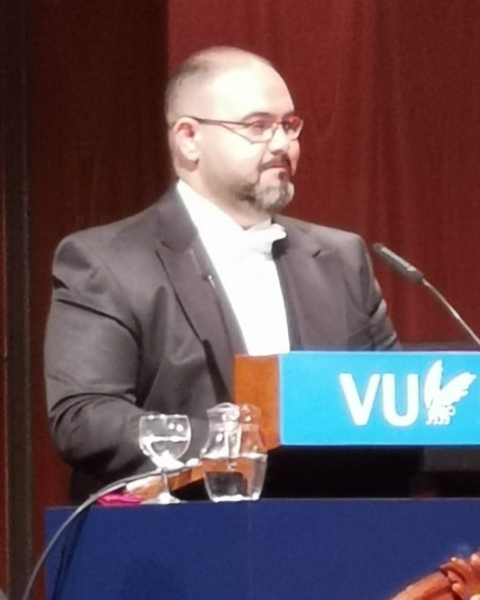SS 43 - Phys 7: Best of Physics
350 - Artificial Intelligence-Assisted Quantitative CT Analysis of Airway Changes Following SABR for Central Lung Tumors
Wednesday, October 2, 2024
11:20 AM - 11:30 AM ET
Location: Room 145

Omar Bohoudi, PhD
Amsterdam UMC location VUMC
Amsterdam, Noord-Holland
Presenter(s)
H. Tekatli1, O. Bohoudi1, N. Hardcastle2, M. A. Palacios1, F. L. Schneiders1, A. Bruynzeel1, S. Siva2, and S. Senan1; 1Amsterdam UMC, Amsterdam, Netherlands, 2Peter MacCallum Cancer Centre, Melbourne, VIC, Australia
Purpose/Objective(s): Late pulmonary toxicity, including bronchial stenosis and fatal hemoptysis, can manifest in up to 35% of patients with central lung tumors treated using stereotactic ablative radiotherapy (SABR). Reliable tolerance doses for central airways are currently lacking. We postulated that objective and earlier identification of airway toxicity may be possible with an automated scoring method using quantitative CT and artificial intelligence (AI)-based airway segmentation to quantify post-SABR bronchial stenosis or occlusion. Materials/
Methods: Patients treated with central lung SABR at two institutions were selected in an Ethics-approved study to define an internal reference dataset and an external validation dataset. Patients were eligible if they had pre- and post-SABR CT scans with =1mm slice thickness. Automated scoring was initiated by AI-based airway auto-segmentation using MEDPSeg, an end-to-end deep learning-based model (http://arxiv.org/abs/2312.02365). Next, the Vascular Modeling Toolkit in 3D Slicer (https://www.slicer.org) was used to extract a centerline curve through the auto-segmented airway lumen, and cross-sectional measurements were computed along each bronchial segment for all CT scans. Stenosis was significant if (100*(median radius-minimum radius)÷median radius) = =50%. For the internal dataset, airways were evaluated by both visual assessment and automated scoring. Stenosis detected only by automated scoring were jointly reviewed by two investigators to reach consensus. Only the automated method was applied to the external dataset.
Results: A total of 26 and 33 patients were studied in the internal and external dataset, respectively. Visual scoring identified stenosis or occlusion in 8 patients from the internal set (31%), most frequently seen in the segmental bronchi. After airway auto-segmentation, minor manual edits were needed in 9% of patients. Time for segmenting a single scan averaged 83sec (range 73-136). Repeat measurements of airway diameters in the contralateral unirradiated lung revealed average relative differences (standard deviations) of 4.7% (± 6.3%), 5.2% (± 9.9%), and 4.9% (± 15.5%) respectively, for the main, lobar, and segmental bronchi. Automated scoring nearly doubled the detected cases of airway changes (n = 15, 58%), and allowed for earlier detection in 5/8 patients who had also visually scored changes, by a mean of 4 months. Estimated rates of airway damage were 48% and 66% at 1- and 2-years, respectively, for the internal set. The automated detection rate for airway damage was 52% in the external set, with 1- and 2-year risks of 56% and 61%, respectively.
Conclusion: An AI-based automated scoring method detected more bronchial stenosis and/or occlusion after central lung SABR and did so at earlier time-points. Detection of early airway changes using this technique can allow for more reliable airway tolerance doses.
Purpose/Objective(s): Late pulmonary toxicity, including bronchial stenosis and fatal hemoptysis, can manifest in up to 35% of patients with central lung tumors treated using stereotactic ablative radiotherapy (SABR). Reliable tolerance doses for central airways are currently lacking. We postulated that objective and earlier identification of airway toxicity may be possible with an automated scoring method using quantitative CT and artificial intelligence (AI)-based airway segmentation to quantify post-SABR bronchial stenosis or occlusion. Materials/
Methods: Patients treated with central lung SABR at two institutions were selected in an Ethics-approved study to define an internal reference dataset and an external validation dataset. Patients were eligible if they had pre- and post-SABR CT scans with =1mm slice thickness. Automated scoring was initiated by AI-based airway auto-segmentation using MEDPSeg, an end-to-end deep learning-based model (http://arxiv.org/abs/2312.02365). Next, the Vascular Modeling Toolkit in 3D Slicer (https://www.slicer.org) was used to extract a centerline curve through the auto-segmented airway lumen, and cross-sectional measurements were computed along each bronchial segment for all CT scans. Stenosis was significant if (100*(median radius-minimum radius)÷median radius) = =50%. For the internal dataset, airways were evaluated by both visual assessment and automated scoring. Stenosis detected only by automated scoring were jointly reviewed by two investigators to reach consensus. Only the automated method was applied to the external dataset.
Results: A total of 26 and 33 patients were studied in the internal and external dataset, respectively. Visual scoring identified stenosis or occlusion in 8 patients from the internal set (31%), most frequently seen in the segmental bronchi. After airway auto-segmentation, minor manual edits were needed in 9% of patients. Time for segmenting a single scan averaged 83sec (range 73-136). Repeat measurements of airway diameters in the contralateral unirradiated lung revealed average relative differences (standard deviations) of 4.7% (± 6.3%), 5.2% (± 9.9%), and 4.9% (± 15.5%) respectively, for the main, lobar, and segmental bronchi. Automated scoring nearly doubled the detected cases of airway changes (n = 15, 58%), and allowed for earlier detection in 5/8 patients who had also visually scored changes, by a mean of 4 months. Estimated rates of airway damage were 48% and 66% at 1- and 2-years, respectively, for the internal set. The automated detection rate for airway damage was 52% in the external set, with 1- and 2-year risks of 56% and 61%, respectively.
Conclusion: An AI-based automated scoring method detected more bronchial stenosis and/or occlusion after central lung SABR and did so at earlier time-points. Detection of early airway changes using this technique can allow for more reliable airway tolerance doses.
